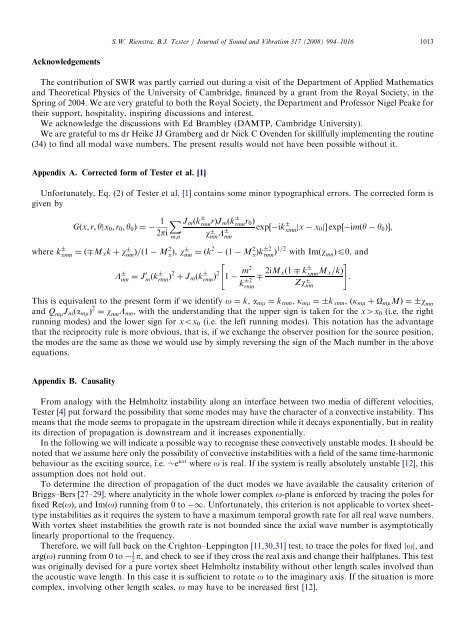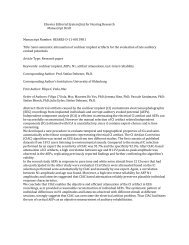An analytic Green's function for a lined circular duct containing ...
An analytic Green's function for a lined circular duct containing ...
An analytic Green's function for a lined circular duct containing ...
Create successful ePaper yourself
Turn your PDF publications into a flip-book with our unique Google optimized e-Paper software.
Acknowledgements<br />
The contribution of SWR was partly carried out during a visit of the Department of Applied Mathematics<br />
and Theoretical Physics of the University of Cambridge, financed by a grant from the Royal Society, in the<br />
Spring of 2004. We are very grateful to both the Royal Society, the Department and Professor Nigel Peake <strong>for</strong><br />
their support, hospitality, inspiring discussions and interest.<br />
We acknowledge the discussions with Ed Brambley (DAMTP, Cambridge University).<br />
We are grateful to ms dr Heike JJ Gramberg and dr Nick C Ovenden <strong>for</strong> skillfully implementing the routine<br />
(34) to find all modal wave numbers. The present results would not have been possible without it.<br />
Appendix A. Corrected <strong>for</strong>m of Tester et al. [1]<br />
Un<strong>for</strong>tunately, Eq. (2) of Tester et al. [1] contains some minor typographical errors. The corrected <strong>for</strong>m is<br />
given by<br />
Gðx; r; yjx0; r0; y0Þ ¼<br />
1<br />
2pi<br />
X<br />
m;n<br />
JmðkrmnrÞJmðk rmnr0Þ exp½ ikxmnjx x0jŠ exp½ imðy y0ÞŠ,<br />
wmnLmn where kxmn ¼ð Mxk þ wmnÞ=ð1 M2 xÞ, wmn ¼ðk2 ð1 M2 x rmnÞ1=2 with ImðwmnÞp0, and<br />
Lmn ¼ J 0 mðkrmnÞ2 þ JmðkrmnÞ 2 1 m2<br />
" #<br />
2iMxð1 kxmnMx=kÞ .<br />
Zwmn This is equivalent to the present <strong>for</strong>m if we identify o ¼ k, amm ¼ krmn, kmm ¼ kxmn, ðkmm þ OmmMÞ ¼ w mn<br />
and Q mmJmðammÞ 2 ¼ w mnLmn, with the understanding that the upper sign is taken <strong>for</strong> the x4x0 (i.e. the right<br />
running modes) and the lower sign <strong>for</strong> xox0 (i.e. the left running modes). This notation has the advantage<br />
that the reciprocity rule is more obvious, that is, if we exchange the observer position <strong>for</strong> the source position,<br />
the modes are the same as those we would use by simply reversing the sign of the Mach number in the above<br />
equations.<br />
Appendix B. Causality<br />
ARTICLE IN PRESS<br />
S.W. Rienstra, B.J. Tester / Journal of Sound and Vibration 317 (2008) 994–1016 1013<br />
From analogy with the Helmholtz instability along an interface between two media of different velocities,<br />
Tester [4] put <strong>for</strong>ward the possibility that some modes may have the character of a convective instability. This<br />
means that the mode seems to propagate in the upstream direction while it decays exponentially, but in reality<br />
its direction of propagation is downstream and it increases exponentially.<br />
In the following we will indicate a possible way to recognise these convectively unstable modes. It should be<br />
noted that we assume here only the possibility of convective instabilities with a field of the same time-harmonic<br />
behaviour as the exciting source, i.e. eiot where o is real. If the system is really absolutely unstable [12], this<br />
assumption does not hold out.<br />
To determine the direction of propagation of the <strong>duct</strong> modes we have available the causality criterion of<br />
Briggs–Bers [27–29], where <strong>analytic</strong>ity in the whole lower complex o-plane is en<strong>for</strong>ced by tracing the poles <strong>for</strong><br />
fixed ReðoÞ, andImðoÞrunning from 0 to 1. Un<strong>for</strong>tunately, this criterion is not applicable to vortex sheettype<br />
instabilities as it requires the system to have a maximum temporal growth rate <strong>for</strong> all real wave numbers.<br />
With vortex sheet instabilities the growth rate is not bounded since the axial wave number is asymptotically<br />
linearly proportional to the frequency.<br />
There<strong>for</strong>e, we will fall back on the Crighton–Leppington [11,30,31] test, to trace the poles <strong>for</strong> fixed joj, and<br />
argðoÞ running from 0 to 1<br />
2 p, and check to see if they cross the real axis and change their halfplanes. This test<br />
was originally devised <strong>for</strong> a pure vortex sheet Helmholtz instability without other length scales involved than<br />
the acoustic wave length. In this case it is sufficient to rotate o to the imaginary axis. If the situation is more<br />
complex, involving other length scales, o may have to be increased first [12].<br />
k 2<br />
rmn<br />
Þk 2
















